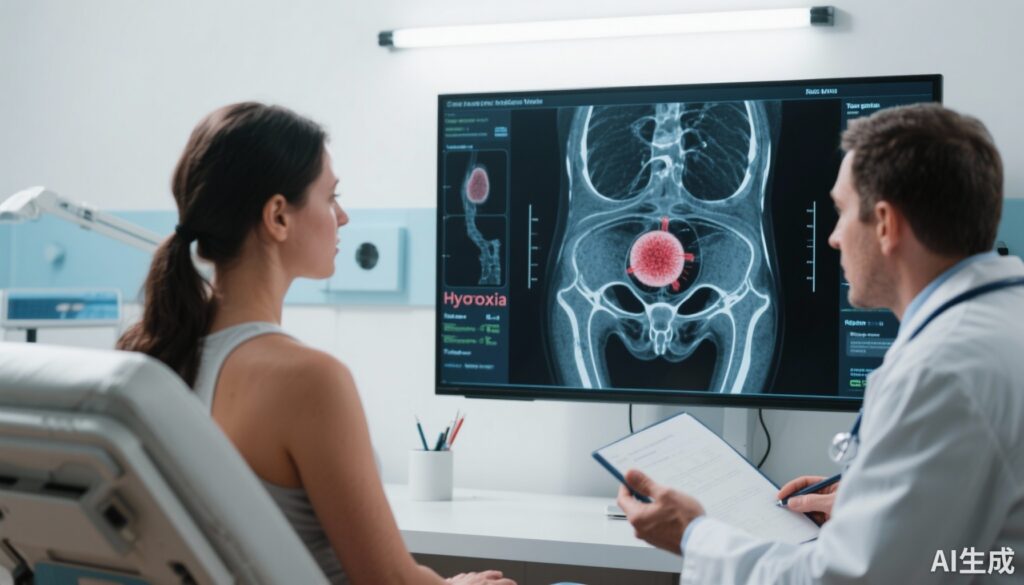Highlight
- Metformin combined with chemoradiotherapy is safe and well-tolerated in locally advanced cervical cancer patients.
- The addition of metformin does not increase severe adverse events compared to chemoradiotherapy alone.
- MRI and tumor biopsy assessments for hypoxia biomarkers were successfully implemented throughout the study, affirming feasibility.
- Initial safety evaluations show no concerning early increase in tumor hypoxia with metformin administration.
Study Background and Disease Burden
Locally advanced cervical cancer (LACC) remains a significant global health challenge, with high morbidity and mortality rates, especially in low- and middle-income countries. The standard of care for LACC is concurrent chemoradiotherapy, typically involving cisplatin-based chemotherapy alongside external beam radiotherapy and brachytherapy. However, treatment-related toxicities remain substantial, often compromising patients’ quality of life and potentially limiting the completion of therapy needed for optimal outcomes.
A key biological feature influencing treatment response is tumor hypoxia—regions of low oxygen in the tumor microenvironment associated with radioresistance, poor prognosis, and disease recurrence. Modulating tumor hypoxia is thus a promising therapeutic approach to enhance radiation efficacy.
Metformin, an established antidiabetic medication, has garnered interest for its potential anticancer effects, including modulation of tumor metabolism and oxygenation. Preclinical data suggest metformin may reduce hypoxia by improving mitochondrial function and tumor perfusion. This randomized phase II trial aimed to evaluate the tolerability, safety, and feasibility of adding metformin to standard chemoradiotherapy in LACC, while assessing early changes in tumor hypoxia biomarkers using established MRI techniques and repeat tumor biopsies.
Study Design
This open-label, phase II randomized clinical trial enrolled patients with LACC, allocated in a 1:1 ratio to receive either standard chemoradiotherapy alone or combined with oral metformin. The intervention arm received metformin at a dose of 850 mg twice daily starting one week before, and continuing through, the course of chemoradiotherapy.
Patients underwent serial imaging with magnetic resonance imaging (MRI) as well as tumor biopsies at three key time points: baseline (before metformin initiation), after one week of metformin monotherapy (pre-chemoradiotherapy), and at the time of brachytherapy. These samples enabled assessment of tumor hypoxia using MRI-based biomarkers and histopathological analysis.
Primary endpoints focused on safety and tolerability, assessed via treatment completion rates and frequency and severity of adverse events graded by Common Terminology Criteria for Adverse Events (CTCAE). Safety was additionally evaluated by monitoring change in tumor hypoxia after one week of metformin, with pre-specified limits to detect any detrimental hypoxia increase. Feasibility was gauged by the proportion of scheduled interventions and evaluations successfully completed with adequate quality.
Key Findings
A total of 41 patients were randomized, with 18 assigned to the metformin plus chemoradiotherapy arm and 23 to chemoradiotherapy alone. Among those in the metformin arm, 18 patients completed at least one week of metformin, and 15 patients completed five weeks of treatment concurrent with chemoradiotherapy.
Safety analysis revealed no significant difference in rates of grade 3 or higher adverse events between the two arms. The most common treatment-related toxicities were gastrointestinal, consistent with known side-effect profiles of both chemoradiotherapy and metformin. Importantly, no unexpected severe adverse events attributable to metformin were noted.
Tumor hypoxia, measured by MRI parameters, did not increase beyond the defined safety threshold during the first week of metformin administration, alleviating concerns about potential early adverse effects on tumor oxygenation.
Feasibility was excellent, with 98% of scheduled MRI scans and tumor biopsy specimens collected and deemed of sufficient quality for analysis. This high adherence confirms the practicality of integrating serial imaging and tissue sampling into clinical trials evaluating hypoxia-modifying interventions.
These results collectively establish that metformin can be safely administered alongside chemoradiotherapy in this patient population without compromising treatment adherence or increasing severe toxicity risks. Moreover, advanced biomarker-based assessments to monitor tumor microenvironment changes are practical within this framework.
Expert Commentary
The demonstrated tolerability and safety of metformin combined with chemoradiotherapy in LACC is promising, especially given mounting evidence of metformin’s potential as a radiosensitizer and metabolism modulator. The study’s rigorous approach using serial MRI and biopsy for hypoxia biomarker assessment addresses a critical gap in translational research and provides a valuable model for future clinical investigations.
Despite the encouraging safety profile, larger studies powered for clinical efficacy endpoints are needed to determine whether metformin can truly improve oncologic outcomes by mitigating hypoxia-driven resistance.
It is also noteworthy that most adverse events remained within expected ranges and manageable, supporting metformin’s suitability for repurposing in this context. Challenges in implementing repeated invasive tumor biopsies were overcome, indicating that such procedures, coupled with noninvasive imaging, can effectively monitor microenvironmental treatment effects.
Clinicians should be mindful of gastrointestinal side effects when introducing metformin concurrently with chemoradiotherapy but can be reassured by the lack of additional severe toxicities in this trial.
Conclusion
This phase II randomized study establishes that adding metformin to the standard chemoradiotherapy regimen for locally advanced cervical cancer is feasible, safe, and well-tolerated. Importantly, the integration of serial MRI imaging and tumor biopsy for hypoxia biomarker evaluation is achievable and delivers high-quality data.
These findings lay critical groundwork for subsequent trials designed to evaluate metformin’s efficacy in improving treatment response by targeting hypoxia and tumor metabolism. Addressing the significant morbidity and therapeutic resistance in LACC through such adjunctive strategies holds promise for enhancing patient outcomes.
Continued investigation is warranted to define metformin’s role within cervical cancer treatment algorithms, optimize dosing schedules, and clarify mechanistic pathways underlying its potential radiosensitizing effects.
References
Skipar K, Hompland T, Lund KV, Fjeldbo CS, Lindemann K, Hellebust TP, Lyng H, Bruheim K. Tolerability, safety and feasibility of metformin combined with chemoradiotherapy in patients with locally advanced cervical cancer: A phase II, randomized study. Acta Oncol. 2025 Mar 19;64:439-447. doi: 10.2340/1651-226X.2025.43045. PMID: 40105683; PMCID: PMC11971942.
Brizel DM, Scully SP, Harrelson JM, et al. Tumor hypoxia affects the pattern of failure following radiotherapy in patients with cervical cancer. Int J Radiat Oncol Biol Phys. 1997;38(3):635-639.
Pollak M. Metformin and other biguanides in oncology: advancing the research agenda. Cancer Prev Res (Phila). 2010;3(9):1060-1065.
Schuler KM, Dutta PR. Tumor hypoxia: metabolism and radiotherapy resistance. Clin Cancer Res. 2020;26(22):5857-5863.



